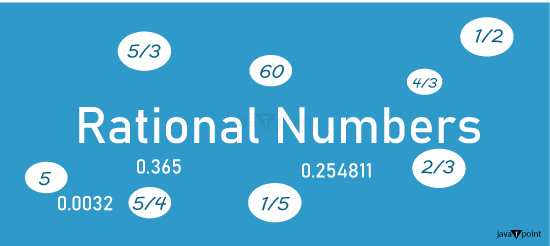1 is a Positive or a Negative Rational Number?What are Rational Numbers?A rational number is said to be represented by the ratio p/q if both p and q are integers and q is not equal to 0. A rational number, for instance, has the fundamental form p/q, where p and q are integers and q≠0. 
Countless additional rational numbers can be found between any two rational numbers. If we have two rational numbers, say 10 and 20, for example. Then, by switching the denominators, we can quickly produce an unlimited number of rational numbers between any two given integers by using denominators like 10/1, 10/2, 10/3, 10/4, 10/5 and so on. A rational number can be written in various ways using the primary form of expression. Examples of rational numbers include 4, 41, 332, 0.25, -158, -0.11, 7/4, -8/3, and -1.1. However, since q=0 in this case, 4/0 is not represented by a rational integer. Properties of Rational NumbersClosure PropertyUnder addition, subtraction, multiplication, and division operations, rational numbers are closed. In simple words, adding, subtracting, multiplying, and dividing two rational integers, "a" and "b," results in a rational number. In rational numbers (p/q form), q ≠ 0. If q = 0, the result is undefined. For example:
Commutative PropertyUnder addition and multiplication, rational numbers are commutative. However, this characteristic does not cover the division or subtraction of two rational numbers. ⇒ a + b = b + a, where a and b are two rational numbers And, a × b = b × a ⇒ a - b ≠ b - a, And, a ÷ b ≠ b ÷ a Associative PropertyOnly addition and multiplication are possible using the associative property of rational numbers. For example: ⇒ a + (b + c) = (a + b) + c, where a and b are 2 rational numbers And, a × (b × c) = (a × b) × c
Distributive PropertyThis property states that a whole number's multiplication is evenly distributed over the total of the whole numbers. ⇒ a × (b + c) = (a × b) + (a × c), here a and b are two rational numbers For example:
Identity PropertyAccording to the Identity property, 0 is an additive identity, and 1 is a multiplicative identity for rational numbers. ⇒ a/b + 0 = a/b (Additive Identity) a/b x 1 = a/b (Multiplicative Identity) For example:
Inverse PropertyThe identity property states that the additive inverse of the rational number a/b is -a/y, and the multiplicative inverse is b/a. ⇒ a/b + (-a/b) = 0 , here the additive inverse of a/b = (-a/b) And, a/b x b/a = 1, here the multiplicative inverse a/b = b/a For example:
Positive and Negative Rational NumberPositive and negative rational numbers are two different types of rational numbers. A rational integer is positive if the numerator and the fraction's denominator expressing it have the same sign. For example, numbers like 3/4 , -11/-6 Any fraction representing a rational number has a negative numerator or denominator, indicating that the rational number is negative. For example, numbers like, -3/4 , 11/-6 All rational numbers can be represented as points on a number line. Positive rational numbers exceed zero. They are located on a number line to the right of 0. Negative rational numbers are less than 0. On a number line, they are situated after 0 to the left. Similar to how you discovered the opposites of integers, you may find the opposites of rational numbers that are not integers. Any rational numbers are said to be opposites when they are equally far from zero but are on opposite sides of zero. Is 1 a positive or a negative rational number?A rational number can be expressed as a whole number, quotient, or fraction of two integers. They could be zero, positive, negative, or both. In this case, let's consider the number 1. Positive rational numbers are, by definition, those bigger than zero, while negative rational numbers are those lower than zero. It is clear from the number 1 that it is bigger than zero. As a result, it satisfies the requirements for being categorised as a positive rational number. Understanding that rational numbers can also be written as fractions with a numerator and a denominator is essential. 1/1 is what we get when we divide 1 by a fraction. 1 represents a positive number in the numerator, which is 1. Despite this, the denominator, also 1, does not suggest a change in sign because a positive number's positivity is unaffected by a division by 1. Therefore, we conclude that the value of the fraction 1/1, or just 1, is still positive.
Next Topic1 Radian to Degrees
|
 For Videos Join Our Youtube Channel: Join Now
For Videos Join Our Youtube Channel: Join Now
Feedback
- Send your Feedback to [email protected]
Help Others, Please Share










